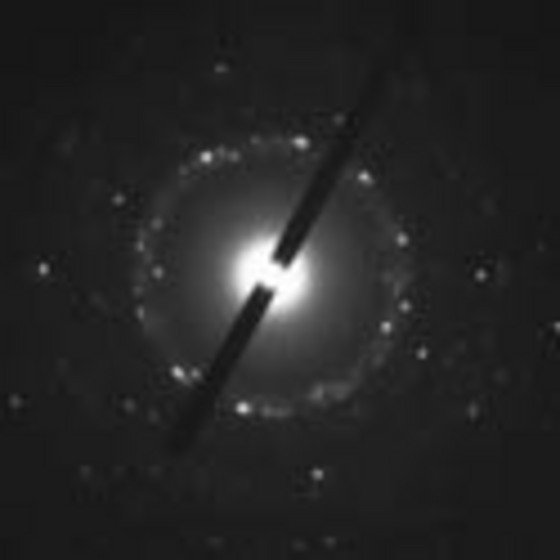Home > Press > Nanoparticles get svelter in the heat: Scientists have discovered magnetic nanoparticles that, unlike most materials, shrink when they are heated
 |
| Figure 1: The distance between the white spots in this electron diffraction pattern are inversely proportional to the distance between atoms in the CuO nanoparticles and will move closer together or further apart depending on whether the nanoparticles expand or contract, respectively, when they are heated. |
Abstract:
Materials typically expand when they are heated, which is why the concrete slabs in sidewalks can buckle on a hot day. Now, Kenichi Kato of the RIKEN SPring-8 Center in Harima and colleagues at Saga University and Japan's National Institute of Advanced Industrial Science and Technology have identified several materials that defy this common rule of thumb. In a paper published in Nature Nanotechnology, the team reports that nanoparticles of cupric oxide (CuO) actually shrink when they are heated1.
Nanoparticles get svelter in the heat: Scientists have discovered magnetic nanoparticles that, unlike most materials, shrink when they are heated
Japan | Posted on February 19th, 2009To make the nanoparticles, Kato and colleagues started with large crystals of CuO and milled them down to particles approximately 5 nanometers in size. Using x-ray and electron diffraction (Fig. 1), they measured the average distances between the atoms that make up CuO and how these distances vary with temperature. Starting from low temperatures (-253.15 °C), they found that CuO shrinks by about 1% from its original volume when it is heated to 200 K (-73.15 °C)—an effect that is several times larger than what is found in other materials that shrink when heated. With further heating, the nanoparticles started to expand.
The reason that materials, in general, expand when they are heated is that the atoms start to vibrate around their equilibrium positions as they gain energy and move away from one another. The opposite case—negative thermal expansion—can occur if the vibrations of some atoms actually pull other atoms together. For example, if an oxygen atom that bonds two metal atoms starts to vibrate perpendicular to this bond, it will pull the two metal atoms closer together. However, Kato and his colleagues believe that the negative thermal expansion in CuO nanoparticles may be related to this material's magnetic properties, since the crossover from normal to negative thermal expansion in the nanoparticles occurs at the same temperature that the CuO orders magnetically.
This effect is also found in nanoparticles of the magnetic material manganese (II) fluoride (MnF2). "As the temperature is cooled and CuO orders magnetically, the magnetic Cu atoms begin to be aligned like a pair of bar magnets," explains Xu-Guang Zheng from Saga University. "The two bar magnets push each other so that the distance between the two magnetic atoms expands." Conversely, as the temperature increases, the Cu atoms push against each other less, leading to negative thermal expansion. Since this is a general argument, the team expects they will be able to find other magnetic materials in nanoparticle form that will exhibit negative thermal expansion.
Reference
Zheng, X.G., Kubozono, H., Yamada, H., Kato, K., Ishiwata, Y. & Xu, C.N. Giant negative thermal expansion in magnetic nanocrystals. Nature Nanotechnology 3, 724-726 (2008).
The corresponding author for this highlight is based at the RIKEN Structural Materials Science Laboratory
####
For more information, please click here
Copyright © Riken
If you have a comment, please Contact us.Issuers of news releases, not 7th Wave, Inc. or Nanotechnology Now, are solely responsible for the accuracy of the content.
| Related Links |
| Related News Press |
News and information
![]() Simulating magnetization in a Heisenberg quantum spin chain April 5th, 2024
Simulating magnetization in a Heisenberg quantum spin chain April 5th, 2024
![]() NRL charters Navy’s quantum inertial navigation path to reduce drift April 5th, 2024
NRL charters Navy’s quantum inertial navigation path to reduce drift April 5th, 2024
![]() Discovery points path to flash-like memory for storing qubits: Rice find could hasten development of nonvolatile quantum memory April 5th, 2024
Discovery points path to flash-like memory for storing qubits: Rice find could hasten development of nonvolatile quantum memory April 5th, 2024
Discoveries
![]() Chemical reactions can scramble quantum information as well as black holes April 5th, 2024
Chemical reactions can scramble quantum information as well as black holes April 5th, 2024
![]() New micromaterial releases nanoparticles that selectively destroy cancer cells April 5th, 2024
New micromaterial releases nanoparticles that selectively destroy cancer cells April 5th, 2024
![]() Utilizing palladium for addressing contact issues of buried oxide thin film transistors April 5th, 2024
Utilizing palladium for addressing contact issues of buried oxide thin film transistors April 5th, 2024
Materials/Metamaterials/Magnetoresistance
![]() Nanoscale CL thermometry with lanthanide-doped heavy-metal oxide in TEM March 8th, 2024
Nanoscale CL thermometry with lanthanide-doped heavy-metal oxide in TEM March 8th, 2024
![]() Focused ion beam technology: A single tool for a wide range of applications January 12th, 2024
Focused ion beam technology: A single tool for a wide range of applications January 12th, 2024
Announcements
![]() NRL charters Navy’s quantum inertial navigation path to reduce drift April 5th, 2024
NRL charters Navy’s quantum inertial navigation path to reduce drift April 5th, 2024
![]() Discovery points path to flash-like memory for storing qubits: Rice find could hasten development of nonvolatile quantum memory April 5th, 2024
Discovery points path to flash-like memory for storing qubits: Rice find could hasten development of nonvolatile quantum memory April 5th, 2024
|
|
||
|
|
||
| The latest news from around the world, FREE | ||
|
|
||
|
|
||
| Premium Products | ||
|
|
||
|
Only the news you want to read!
Learn More |
||
|
|
||
|
Full-service, expert consulting
Learn More |
||
|
|
||








